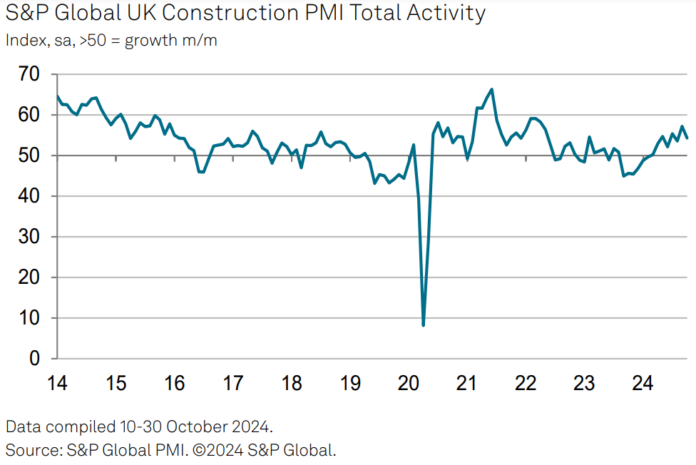Latest PMI data has indicated that output growth slowed considerably across the UK’s construction sector after reaching a 29-month high during September.
The headline S&P Global UK Construction Purchasing Managers’ Index (PMI) registered 54.3 in October, down from 57.2 in September. However, the index was above the crucial 50.0 no-change threshold for the eighth month running. The latest reading was also well above the average seen in the first half of 2024 (51.4) and signalled a solid expansion of total industry activity.
Index breakdown
Civil engineering (56.2) was by far the best-performing category of construction output in October. Survey respondents again noted rising demand across a range of energy infrastructure projects, especially renewables. Commercial work (52.8) also expanded in October, but the increase was the weakest since the current period of growth began in April.
House building (49.4) was the only broad category of construction work to register an overall decline in output during October. This was the first decrease in residential activity since June, but the rate of contraction was only marginal. Some construction companies noted that elevated borrowing costs and uncertainty ahead of the Autumn Budget had constrained demand.
New work
Total new work expanded at a solid pace in October. Mirroring the trend for output growth, the latest expansion was softer than the two-and-a-half year high seen in September. Political uncertainty and subdued household demand due to cost-of-living pressures were cited as factors limiting new order growth in October.
However, many construction companies noted strong sales pipelines and tender opportunities linked to generally improving domestic economic conditions.
Construction companies also continued to boost their purchasing activity in October, which was mainly linked to greater workloads and forthcoming new project starts. However, the latest increase in purchasing activity was only marginal and the weakest since the current phase of expansion began in May.
Lead times
Suppliers’ delivery times improved marginally in October. Lead times have now shortened in each of the past three months, which was often linked to rising inventories among suppliers. Some construction firms noted that international shipping disruptions had limited the latest improvement in vendor performance.
Average cost burdens meanwhile increased at a solid pace. The rate of inflation remained stronger than seen on average in the first half of 2024, but moderated since September. Survey respondents typically commented on higher raw material prices. Many firms suggested that an improved balance between supply and demand for construction inputs had led to increased competition between suppliers and helped to limit overall cost pressures.
Job creation
Higher levels of new business encouraged additional staff recruitment in October. Moreover, the rate of job creation accelerated to a three-month high. Greater demand for staff was recorded in spite of a decline in business optimism regarding growth prospects for the year ahead. Latest data indicated that construction companies were the least confident about their output growth projections since December 2023.




